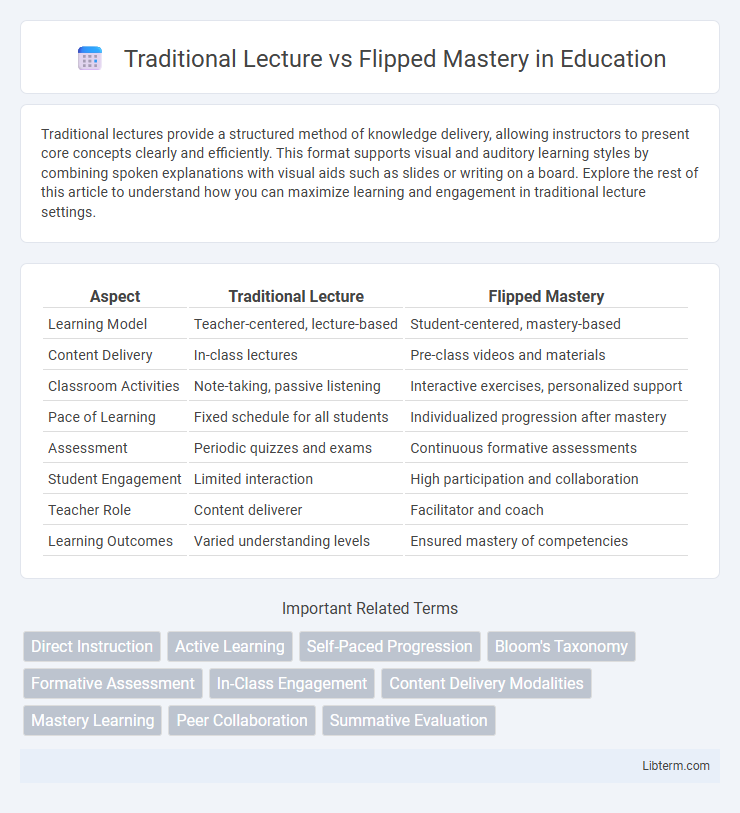Traditional lectures provide a structured method of knowledge delivery, allowing instructors to present core concepts clearly and efficiently. This format supports visual and auditory learning styles by combining spoken explanations with visual aids such as slides or writing on a board. Explore the rest of this article to understand how you can maximize learning and engagement in traditional lecture settings.
Table of Comparison
| Aspect | Traditional Lecture | Flipped Mastery |
|---|---|---|
| Learning Model | Teacher-centered, lecture-based | Student-centered, mastery-based |
| Content Delivery | In-class lectures | Pre-class videos and materials |
| Classroom Activities | Note-taking, passive listening | Interactive exercises, personalized support |
| Pace of Learning | Fixed schedule for all students | Individualized progression after mastery |
| Assessment | Periodic quizzes and exams | Continuous formative assessments |
| Student Engagement | Limited interaction | High participation and collaboration |
| Teacher Role | Content deliverer | Facilitator and coach |
| Learning Outcomes | Varied understanding levels | Ensured mastery of competencies |
Introduction to Traditional Lecture and Flipped Mastery
Traditional Lecture relies on instructor-centered delivery where students passively receive information during class time, typically through oral presentations and note-taking. Flipped Mastery inverts this model by having students engage with instructional content outside of class, allowing class time to be dedicated to active problem-solving, personalized support, and mastery of concepts. This approach enhances student engagement and supports differentiated learning paces tailored to individual needs.
Defining the Traditional Lecture Model
The Traditional Lecture Model centers on a teacher delivering content directly to students, often in a one-way communication format that emphasizes passive learning. Students primarily listen, take notes, and complete homework assignments independently to reinforce concepts taught during class. This model relies heavily on structured schedules and uniform pace, limiting personalized learning and real-time student engagement.
Key Elements of Flipped Mastery Learning
Flipped Mastery Learning emphasizes student-centered instruction by allowing learners to engage with lecture materials at their own pace before class, promoting mastery through personalized feedback and competency-based assessments. Key elements include self-paced content consumption, active in-class application, and continuous formative assessments to ensure understanding before progression. This model cultivates deeper learning by shifting focus from passive listening to active problem-solving and teacher-guided support.
Student Engagement in Both Approaches
Traditional lecture often results in passive student engagement, as learners primarily listen and take notes, limiting interaction and immediate feedback. Flipped Mastery increases student engagement by requiring active participation through pre-class content review and in-class practical application, promoting deeper understanding. Research shows that Flipped Mastery improves retention rates and motivation by fostering a learner-centered environment with continuous assessment.
Instructional Design: Structure and Flexibility
Traditional lectures follow a linear instructional design with fixed pacing and teacher-centered delivery, often limiting student engagement and personalization. Flipped mastery incorporates a flexible, student-centered approach where learners control the pace and sequence of content mastery, enabling differentiated instruction tailored to individual needs. This structure promotes active learning and continuous assessment, enhancing understanding and retention through iterative practice.
Assessment Methods: Summative vs Formative
Traditional lecture primarily relies on summative assessments, such as exams and quizzes, to evaluate student understanding at the end of a learning unit, providing a snapshot of mastery. Flipped mastery emphasizes formative assessments, including frequent quizzes, peer reviews, and real-time feedback, allowing continuous monitoring and adjustment of learning processes. This formative approach promotes deeper comprehension and individualized support by identifying strengths and gaps throughout the instructional period.
Role of the Teacher: Facilitator or Lecturer
In a traditional lecture, the teacher primarily acts as a lecturer delivering content, guiding students through structured lessons with direct instruction. In flipped mastery, the teacher shifts to a facilitator role, supporting students as they engage with material independently and work through personalized mastery-based activities. This approach encourages active learning, with teachers providing targeted feedback and fostering a collaborative classroom environment.
Benefits of Flipped Mastery Over Traditional Lectures
Flipped Mastery promotes active learning by allowing students to engage with materials at their own pace, leading to deeper comprehension and personalized mastery of subjects. This approach increases student motivation and retention by encouraging hands-on activities and immediate application rather than passive note-taking typical in traditional lectures. Educators benefit from more targeted interventions as they can identify and address individual learning gaps in real-time, enhancing overall academic performance and progress tracking.
Challenges and Limitations of Both Models
Traditional lectures often face challenges such as passive student engagement, limited personalized feedback, and difficulty accommodating diverse learning paces, which can hinder mastery of complex subjects. Flipped mastery models require significant upfront effort in content creation, depend heavily on student self-motivation, and may encounter barriers like unequal access to technology and inconsistent in-class support. Both models struggle with scalability and ensuring consistent student outcomes across different educational contexts.
Future Trends in Educational Methodologies
Future trends in educational methodologies increasingly favor Flipped Mastery models, leveraging personalized learning paths and competency-based progression to enhance student engagement and mastery over traditional lecture-based approaches. Adaptive technologies and real-time data analytics enable instructors to tailor flipped classrooms, promoting active learning and immediate feedback that traditional lectures often lack. This paradigm shift aligns with demands for lifelong learning and skill acquisition, positioning Flipped Mastery as a dominant framework in the evolution of education.
Traditional Lecture Infographic

 libterm.com
libterm.com